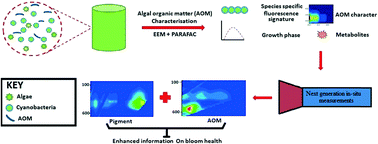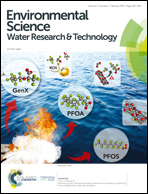Fluorescence spectroscopic characterisation of algal organic matter: towards improved in situ fluorometer development†
Abstract
Online fluorescence probes have been applied for the rapid detection of cyanobacterial and algal cells via measurement of fluorescent cell pigmentation with some success; however, this alone is not a sufficiently robust method to identify specific species, stage of the bloom, or measure the released organic matter. This study investigates whether fluorescence can be applied to characterise the AOM released by cyanobacterial and algal species which, when combined with cell pigmentation measurements, may improve the specificity and robustness of these online methods. The AOM released by key cyanobacterial (Dolichospermum circinalis, Cylindrospermopsis raciborskii, four strains of Microcystis aeruginosa) and algal (Chlorella vulgaris) species were studied at lab scale throughout their growth using 3D-fluorescent excitation–emission matrix (F-EEMs) spectroscopy combined with parallel factor analysis (PARAFAC). A six-component PARAFAC model was developed for the analysed dataset. Analysis of the PARAFAC data indicated that observations of certain wavelengths could be helpful for AOM monitoring in conjunction with cell pigments, giving information on both, bloom health and AOM character. The relevant wavelengths were shown to vary depending on the species; for example, the fluorescence of amino acid-like material at λex/em = 290/345 nm dominated in the AOM originating from C. vulgaris, while that of M. aeruginosa (CS-555) was dominated by fluorescence at λex/em = 355/475 nm which has previously been associated only with terrestrially delivered substances. Both these fluorescence signatures had significant correlations with the released AOM, measured as dissolved organic carbon (DOC), and dominated across the exponential and stationary phases relative to other PARAFAC components. With fluorescence probes on the market that measure fluorescence in AOM regions, there is an opportunity to monitor these key peaks simultaneously with pigment fluorescence to give further information on the released organic matter character and its treatability.



 Please wait while we load your content...
Please wait while we load your content...